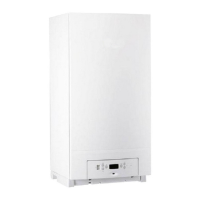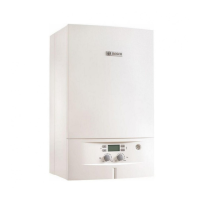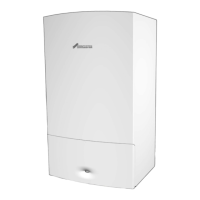Installation
17
Condens 7000 F – 6720871560 (2019/11)
5.6 Establishing the flue gas connection
For position and dimension of flue gas connection
Chapter 2.9, page 8.
DANGER:
Risk to life from escaping flue gas inside at the installation location!
Ensure that the seal in the flue gas connection on the condensation
catch pan is fitted, undamaged and correctly inserted.
DANGER:
Risk to life through toxic exhaust gases escaping.
Check all joints in the flue system to ensure they are correctly made,
secured and sealed.
NOTICE:
Damage to gaskets due to burred edges on the insertion ends of the
pipe parts!
Make sure the insertion ends are free of burrs. If chamfering on site is
required, only do so in accordance with the manufacturer's
documentation.
Flue gas routing for multi-boiler systems (cascade, accessory).
These instructions only concern single boiler systems.
Observe separate technical documentation (information on flue gas
routing and documentation on accessories).
Only ask qualified specialists to calculate and size flue gas /
combustion air systems for multi-boiler systems.
The flue system must prevent a reverse flow of flue gas through
boilers when they are not in use.
Only original accessories may be used for positive pressure cascades
(conversion set and flue gas piping).
Compare data plate with label on the retaining plate of the burner
control unit.
Observe all country-specific requirements when installing the flue
system.
The flue gas connection is supplied ex works for connection at the rear.
The flue gas connection can also be made at the top. The following
conversion measures are required for this:
with boiler rating 75-100 kW:
Install 90°flue bend (accessory) outside the casing on the factory-
installed flue gas connection and install the flue mechanically
uncompressed.
With boiler rating 150-300 kW:
Remove factory-installed 90° flue bend.
Plug the straight pipe section (accessory) onto the connector on the
condensation catch pan and install the flue mechanically
uncompressed.
The flue system is to be carried out either in accordance with pressure
classification (EN 1443) H1 or pressure classification (EN 1443) P1
with additional mechanical impact stability up to 5000 Pa.
Table 6 Pressure classifications of the flue system
When installing the flue gas connection:
Observe the installation instructions for the flue accessories.
Observe national regulations.
Make sure that the flue pipe cross-section is calculated in accordance
with all current regulations.
Select the shortest possible route for the flue pipe and install it with
a slope towards the floor standing boiler.
Fasten the flue securely at 1 m intervals.
Ensure the connection is mechanically uncompressed, and that no
loads are transferred to the flue gas connection.
During planning and installation of the flue system, create a
layout that best favours the flue gas flow.
The wind barriers for the combustion air supply and the flue gas routing
must be installed on the same wall of the building.
The boiler must not be connected to any combined flue system with
motorised combustion systems (e.g. combined heat and power unit).
Centrocerin (scope of delivery) must be used as a lubricating paste when
installing the flue system on the connector.
Class Leakage rate
I*s-1*m-2
Rated pressure
[Pa]
Mode of operation
P1 0.006 200 Positive pressure/
negative pressure
1)2)
1) Positive pressure up to maximum 200 Pa
2) Usage only with additional mechanical impact stability up to 5000 Pa in the
connection piece
H1 0.006 5000 Positive pressure/
negative pressure
3)
3) Positive pressure up to maximum 5000 Pa

